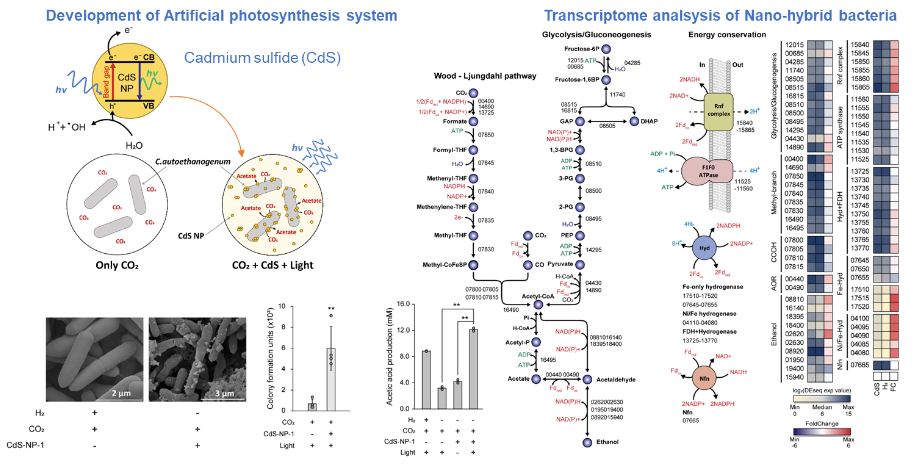C1 gases consist of carbon dioxide (CO2), carbon monoxide (CO), and methane (CH4). Since these gases cause global climate change, such as the greenhouse effect and environmental pollution, the eco-friendly C1 gas conversion technology is in the spotlight around the world.
Prof. Cho’s group developed an artificial photosynthesis system that converts C1 gases into value-added biochemicals by attaching photo-responsive nanoparticles to the outer membrane of acetogenic bacteria. Acetogenic bacteria convert C1 gas feedstocks, such as carbon monoxide (CO) and carbon dioxide (CO2), to acetate through the Wood-Ljungdahl (WL) pathway.
The WL pathway requires redox energy obtained from hydrogen (H2) or sugar to fix C1 gases. To find alternative redox energy sources, Prof. Cho’s group focused on photo-responsive nanoparticles called cadmium sulfide (CdS) that can generate and transfer electrons under light treatment. To transfer electrons into bacteria, they attached CdS nanoparticles to the surface of microorganisms, and revealed that the nano-hybrid microorganisms were able to produce acetate by fixing C1 gases under the light treatment conditions. Furthermore, they demonstrated the intracellular transfer processes of electrons generated from nanoparticles through the transcriptome analysis of the hybrid microorganism.
A previous artificial photosynthesis system was developed by biologically synthesizing CdS and attaching it to the outside of the bacteria. However, this approach was impossible to specify the structure and components of the nanoparticles. This limits the construction of an artificial photosynthesis system using hybrid bacteria because the electron transfer efficiency of photo-responsive nanomaterials varies depending on the structure, composition, and size. Therefore, Prof. Cho’s group improved artificial photosynthesis technology using size- and structure-controlled chemically synthesized CdS nanoparticles displayed on the cell surface.
Prof. Cho said, “We can replace electron obtained from sugar or hydrogen for the C1 gas fixation with eco-friendly light energy, and overcome the limitations of the previous artificial photosynthesis system using microbial-based biosynthetic nanoparticles”, and “these results provide evidence to develop highly efficient artificial photosynthesis.”
This study was published on March 2 in PNAS (Acetogenic bacteria utilize light-driven electrons as an energy source for autotrophic growth, 118(9), 2021) and this work was supported by the Intelligent Synthetic Biology Center of the Global Frontier Project and the C1 Gas Refinery Program through the National Research Foundation of Korea, funded by the Ministry of Science and ICT.

Mr. Sangrak Jin, Prof. Byung-Kwan Cho Dept. of Biological Science, KAIST
Homepage: http://cholab.or.kr
E-mail: bcho@kaist.ac.kr






